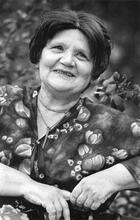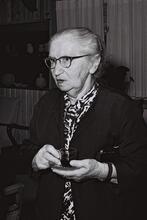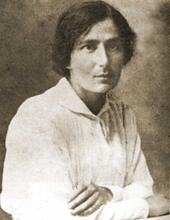Sarah Shmukler
Grave of Sarah Shmukler, Kinneret Cemetery, Israel
From the photographs of Yehudit Nucleus-Kol. From Wikimedia Commons.
Sarah Shmukler did not make aliyah to fulfill an ideological purpose, but rather to accompany her friends and care for the sick and suffering in Palestine. She was born in Bobruisk in the Russian Empire and as a teenager joined a group of intellectuals led by Berl Katznelson. Shmukler went to Kiev to study nursing and midwifery, while Katnzelson and others emigrated to Palestine; Shmukler followed in 1913. She worked for two years at the central hospital in Zikhron Ya’akov, primarily caring for migrant workers. During World War I, Shmukler lived on a collective in the Galilee with others from Bobruisk, though romance threatened their friendships. Shmukler died shortly after the war, and her friends established a rest home in her honor in Jerusalem.
Sarah Shmukler—nurse, midwife, and Second Lit. "ascent." A "calling up" to the Torah during its reading in the synagogue.Aliyah pioneer—is an outstanding example of Israel’s working women. Her death in Yesud ha-Ma’alah in 1919, as she battled a yellow fever epidemic, made her a symbol of the fate of the new woman of the Land of Israel, her creativity and her love. Her grave in the Kinneret Cemetery became a shrine for young pioneer women. Apparently, the poet Rahel Bluwstein expressed a desire to be buried alongside her.
Early Life in the Russian Empire
Sarah Shmukler was born in 1889 in Bobruisk, Byelorussia (now Belarus), where she was active in a group of young intellectuals set up by Berl Katznelson at the local Jewish library, torn between the principles of the First Russian Revolution of 1905 and Zionism. Those who foresaw the revolution’s failure and the subsequent pogroms had many questions with which to wrestle: Should the Jewish Question be solved by mass exodus from the European Lit. (Greek) "dispersion." The Jewish community, and its areas of residence, outside Erez Israel.Diaspora to America, or should the Jews stay put and fight for the victory of the anti-Tsarist revolution, thereby ultimately achieving social progress and cultural autonomy? The failure of the revolution was a turning point for both schools of thought. Many young Jews sank into despair and Jewish public life was effectively suspended. Difficulties were evident in the young circles of Bobruisk as well. Katznelson himself, who tried his hand at physical labor, fell ill, and suffered a severe spiritual crisis. It was feared that the unfolding situation would engender a major moral-ethical upheaval in personal and public life alike.
Shmukler left to study nursing and midwifery at the medical school in Kiev. Katznelson decided to emigrate to Palestine but did not believe that he was doing so as a pioneer problem-solver but rather as one who sought a personal, existential experience of no great public impact. Even after his departure, he maintained ties with the group, corresponding with Sarah and with her friend Leah Miron, sending them critical reports of his life and experiences in Palestine without calling on them to follow him there. That was a decision they had to make on their own. Although Berl dreamed of founding a collective for himself, his family, and his comrades from Bobruisk, he avoided voicing his ideas openly.
Leah Miron was the first of the group to go to Palestine, while Sarah was compelled to postpone her decision until she completed her studies. Arriving in 1912, Leah was respected as an efficient, loyal and skilled worker. Katznelson’s associates, who knew the difficulties he had regarding physical labor and organizing his life, felt that he and Leah would complement one another as a couple.
Making Aliyah in Service of Others
Sarah planned to move to Palestine as well. As a nurse and midwife, she was familiar with human distress, but she did not perceive her aliyah as the fulfillment of any overt ideological principle. Rather, she sought to contribute whatever she could to the people in whom she believed. On her arrival in 1913, she immediately established ties with the Bobruisk group and began working as a medic, summoned to the central hospital in Zikhron Ya’akov, run by Hillel Yaffe. This institution specialized in treating migrant workers and other groups that fell ill frequently because of the living conditions then prevailing in Palestine. In her two years of service at the hospital, Sarah displayed much sensitivity and professional skill, embodying the qualities then considered characteristic of women leaders: Setting a personal example, adhering to a lofty ethical code, and seeking self-fulfillment.
During World War I, members of the Bobruisk group began seeking out one another, attempting to become better organized as the already harsh economic circumstances began to worsen. Sarah Shmukler, Rahel Katznelson (later Shazar), Leah Miron and her sister Shoshana, Yehudit Krivitzky, Batya Schein, Berl Katznelson, and Eliezer Moshe Slutzkin lived cooperatively on the banks of the Sea of Galilee and sought acceptance to the young collective that had taken the Kinneret Farm under its auspices. There was some opposition derived primarily from the fact that Berl Katznelson could not demonstrate any practical skills, but the group was eventually accepted, apparently thanks to the women. At once, cultural activities began to flourish in the Jordan Valley, including Hebrew study groups, a choir, lectures, and technological studies in Hebrew for pioneer families from Yemen.
Romance and Conflict
At the same time, there were considerable tensions within the collective: Shmukler became romantically involved with Berl Katznelson, while Miron and Rachel Katznelson loved him as well, one openly and the other secretly. It was a most complex imbroglio. Shmukler and Berl Katznelson decided to leave for Tel Aviv. Miron, who realized that the two would be at great risk under the harsh economic conditions that then prevailed in Palestine, told her future brother-in-law Eliezer Moshe Slutzkin to look after them and offer them help in time of distress. Berl Katznelson and Shmukler later decided to separate temporarily. She proceeded to Merhavyah and Deganyah, while Berl and several of his comrades went to Jerusalem to set up a vegetable cultivation collective. This was one of a network of women’s groups established throughout Palestine at the end of the war, each one of which included one man who worked together with the women and was responsible for external liaison. These groups displayed keen awareness of the independence of women and the essential nature of their activity during times of famine and distress.
When the British conquered Palestine, the couple found themselves separated by the battlefront. Berl Katznelson was in the south under British rule, while Shmukler was in the north, still under Ottoman control. Berl volunteered for the Jewish Legion and Sarah knew nothing of his fate. Several months later, the British Army conquered the north. Sarah hoped they would now be able to establish a home and family, but Berl was then preoccupied with the grand idea of uniting all the workers’ parties in Palestine. Meanwhile, the Russian Revolution, the Balfour Declaration, and the widespread pogroms in Russia had all left their mark. Berl was disappointed that his plan was never implemented. Shmukler returned to the Galilee at the request of Hillel Yaffe, who assigned her to Yesud Ha-Ma’alah to battle the yellow fever epidemic. Berl visited her there and their personal situation appeared to be improving, but Leah Miron, who was then at Kinneret, had a deep-seated intuitive feeling that something terrible was happening to her friend Sarah. She hastened to Yesud Ha-Ma’alah but did not find Sarah there, as she had been hospitalized in Safed. Realizing that Sarah was dying, Leah contacted Berl.
Sarah’s funeral was a terrible occasion for the Bobruisk group. Berl leapt into her grave with a cry of mourning, despair and self-blame. Her death was a symbol of neglect and helplessness, appearing at a time that had seemed so promising. Sarah’s estate was left to Leah Miron, as were the letters of grief that Berl Katznelson wrote. Leah remained forever loyal to her dear friend. Even her marriage to Berl was a kind of memorial to their beloved comrade. Leah’s niece was named for Sarah Shmukler. Leah, her brother-in-law Eliezer Slutzkin, and her sister Shoshana built Sarah’s monument at the Kinneret Cemetery with their own hands.
Preserving Her Legacy: Arza
After they were married, the Slutzkins left Kinneret to set up a rest home in Sarah Shmukler’s memory at a place called Arzo (Hebrew: his cedar) in Upper Moza. It was here that Theodor Herzl planted a cedar (actually a cypress) tree, since uprooted, when he visited Palestine in 1898. The rest home, called Arza after Sarah Shmukler, was a central facility of the Labor Movement in Palestine. Berl Katznelson himself composed a dedication to all those recuperating there:
Do your convalescents and rest-seekers, who take refuge in your shadow, know the anguish from which you grew? The years of opprobrium of this precious spot where Herzl chose to plant his cedar and the black day on which we heard it was uprooted? Do they know of the life and death of Sarah, whose image looks out at them from the wall? Of her friends who sought to fill this site with the memory of her love, her concern for her fellow human beings and her self-sacrifice? Lo, these tribulations have yielded a blessed enterprise that soothes pain, that grants rest to the weary and strength to the helpless. What better reward could we ask for our suffering?
When Berl died, Leah decided to bury him beside the grave of Sarah Shmukler, behind which lay the poet Rahel Bluwstein. The other side of his grave was reserved for Leah herself. These three graves are a monument to a very special love—unbounded but by no means singular— that bloomed during the Second Aliyah period.
Shapira, Anita. Berl: The Biography of a Socialist Zionist: Berl Katznelson, 1887–1944. Cambridge, UK: Cambridge University Press, 1984.














